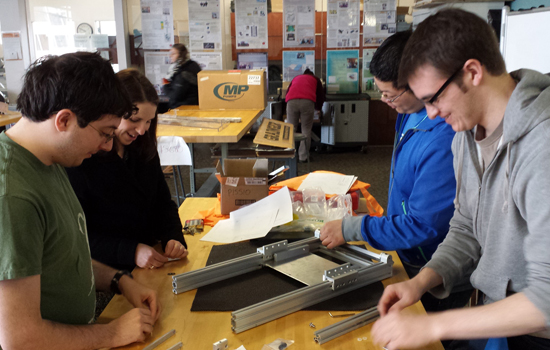Engineering students build tabletop letterpress
Think Gutenberg in your own home! A modernized mechanical device for small run printing
Cary Graphic Arts Collection
RIT engineering students have gone Gutenberg—with a modern designed aluminum tabletop letterpress that manufactures small run printing capabilities to match the historic 19th century platen presses in the Cary Graphic Arts Collection. From left are Kevin Weinstein, Cary Collection Associate Curator Amelia Hugill-Fontanel, George Chiu and Spencer Herzog.
Five engineering students are leaving something behind as they graduate from Rochester Institute of Technology—a handmade tabletop letterpress to join the esteemed collection of historic 19th century printing presses at RIT’s Cary Graphic Arts Collection.
The aluminum hand-operated letterpress, weighing in at 25 pounds and assembled with two Allen wrenches, can produce high quality and repeatable prints—the same as their cast-iron counterparts in the Cary Collection.
“The students designed a platen press and we have several platen presses in the technology collection which are all very heavy,” said Associate Curator of the Cary Collection Amelia Hugill-Fontanel. “One is a freestanding model that is 500-plus pounds and others are small enough to fit on a table top, but still weigh in at 80-plus pounds. So part of this project was to design a lightweight model that we could easily carry, and at a fraction of the price—$750 as compared to a few thousand.”
RIT’s Kate Gleason College of Engineering students collaborated with Hugill-Fontanel since last September to design and manufacture the letterpress, which was unveiled early May during the Imagine RIT: Innovation and Creativity Festival.
Participating in the multidisciplinary senior design class project were mechanical engineering students George Chiu from Rochester, N.Y., Brendan Domos from Belmont, Mass., Nathan Sandidge from Denver, Co., Kevin Weinstein from Fairport, N.Y., and industrial and systems engineering student Spencer Herzog from Saugerties, N.Y.
“Letterpress machines haven’t really been manufactured in the last 50-plus years, so any tabletop press on the market might require serious maintenance before it would work, or if a part was missing or broken, a custom piece would be needed to replace it,” explained Herzog. “Our design uses mostly parts that can be easily ordered to specifications and for a fraction of the price.
“One of the best parts was at Imagine RIT when kids would put paper in the press and be so surprised when it came out with the printed image. To them it was like magic.”
Hugill-Fontanel said the collaboration between the Cary Collection and engineering students has been productive on so many levels. “The students are providing a great service to the burgeoning letterpress and design community by open access publishing their press’s engineering schematics and instructions on how to build it. This may help a new generation of creatives who can now build 21st century alternative to 19th century analog presses.”
Arthur North, adjunct faculty member from Kate Gleason College of Engineering who supervised the group, said the process differs from course and lab work. “Students are taking the project from customer requirements through prototype: engineering requirements, concept selection, detailed design, material ordering, managing the budget, fabrication and testing.
“This team worked well together, with humor, animated discussions, pizza and application of engineering principles. In the end I think it was a win-win for all parties.”
Note: Established at RIT in 1969, the Cary Graphic Arts Collection is one of the country’s premier libraries on graphic communication history and practices. Originally comprised of 2,300 books from the estate of Melbert B. Cary, Jr., the collection has expanded into a comprehensive resource on the development of the alphabet and writing systems, early book formats and manuscripts, calligraphy, typefaces and their manufacturing technologies, bookbinding, papermaking, printing and illustration processes, and artists’ books. The Cary Collection also manages the RIT Graphic Design Archive comprised of 40-plus archives documenting the work of important 20th-century Modernist graphic designers.





